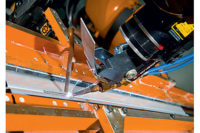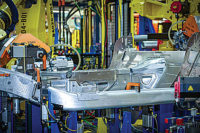Manufacturers are increasingly using aluminum in a variety of assemblies. It offers high strength and corrosion resistance, even at thin gauges, making it desirable for applications in which light weight is a requirement.
Because aluminum’s properties vary greatly from steel, working with the material presents some challenges. These include:
- more sensitivity to heat input and distortion.
- difficulty gaining a good bead appearance.
- the need to more carefully clean and prep the material before welding.
- the possibility of poor fusion or overwelding.
Careful storage of aluminum welding wires is important, too, since they are susceptible to oxidation and moisture contamination. Due to their softer consistency, these wires are also more difficult to feed and usually require a specialized gun and feed system.
Despite these challenges, aluminum isn’t that difficult to weld when using the right welding system and filler metals. In fact, having a system specifically designed for welding aluminum makes attaining high-quality welds relatively easy and more efficient.
In the past, many manufacturers have used TIG welding for aluminum. However, recent advancements in MIG welding technology make it an excellent alternative when working with aluminum. The MIG process offers advantages, such as higher deposition rates, less operator training, and higher productivity.
Which Level Is Needed?
Moving along the scale from light industrial to heavy industrial, aluminum welding systems gain more amperage output, have higher duty cycles, can handle larger wire diameters, and are able to manage longer welds on thicker materials. Power sources in the heavier industrial categories are made for continuous welding, day-in and day-out.
Along with considering the amperage, duty cycle and material thickness needs, another question is whether the job calls for mobility or portability. Some systems are all-in-one machines, with the power source, the wire feeder and the wire itself housed in one box. Often these are on wheels, so the welder is able to move them around the shop as needed. Other systems are more portable. They have handles on the power source and the wire feeder. These features are handy for welders who want to carry the wire feeder to their work or bring it into tight spaces.
Choosing the Transfer Mode
The transfer mode refers to how wire is transferred to the base material during the MIG welding process. Two common methods when MIG welding aluminum are spray transfer and pulsed spray transfer, commonly called pulsed MIG.
In spray transfer, molten droplets are transferred from the electrode to the puddle. The arc is smooth and stable and produces a nice appearance with good fusion at the sides. However, since this process involves high heat, burn-through can be an issue—especially on thinner sections of aluminum. For that reason, this mode of welding requires a faster travel speed and a smaller size filler wire to keep the heat input down.
Power sources offering pulsed MIG welding are a better choice for welding aluminum and are more capable of out-of-position welding. A modified version of the spray transfer process, pulsed MIG welding uses a power source that rapidly switches between a high peak current and a low background current. During the peak current phase, a droplet is pinched off and propelled toward the weld joint. During the background current phase, the arc is maintained, but has such a low current level that spray metal transfer can’t occur. The result is lower heat input and less opportunity for problems like burn-through.
Pulsed MIG welding provides good bead appearance and virtually no spatter. Also, because the weld puddle cools between pulses, it freezes faster. The puddle is less likely to sag or look excessively convex when welding out of position. Because the heat input can be better controlled, welders can weld thinner gauge material and use a larger diameter wire—up to 0.047 inch—which increases deposition rates and productivity, while simultaneously decreasing the chance of burn-through and distortion.
Some aluminum welding systems also offer operator-friendly synergic pulsed MIG welding, in which the power source, feeder and gun communicate with each other. With standard pulsed MIG systems, welders may need to change other settings when they change the wire feed speed. In contrast, a synergic pulsed MIG system automatically adjusts weld parameter settings when the welder changes the wire feed speed. As wire speed increases or decreases, the power level increases or decreases to maintain a constant welding arc.
Manufacturers also offer a newer type of pulse technology for welding aluminum that uses the pulsed MIG process to achieve the highly aesthetic “stacked dime” appearance associated with TIG welding, but with the production speeds of MIG welding. This feature generally changes either pulse parameters or wire feed speed or both between a high and low setting. The result is a ripple pattern or stacked dime appearance. Most equipment allows the welder to modify the type of ripple pattern by changing the frequency.
Wire Feeding Options
There are three ways to feed aluminum wire:
- push-only using a standard system.
- spool gun.
- push-pull system.
Feeding aluminum wire via a push-only system requires using a liner made for aluminum, typically a nylon one. This feeding method can be difficult. “Bird-nesting”—tangling of the wire between the drive roll and the liner—is a common, time-consuming problem with this technology.
Spool guns and push-pull systems are much better options for feeding aluminum wires. Push-pull systems are considered the gold standard in wire feeding.
There are different levels of spool guns. Some are made for smaller machines with lower duty cycles. Others are made for industrial systems operating at much higher amperages. Spool guns eliminate the possibility of tangling by putting a 1-pound spool of wire right on the back of the gun, so the wire only feeds a few inches out to the arc. Spool guns can accommodate aluminum wire diameters from 0.023 to 0.0625 inch and allow the welder to use longer cables.
With a push-pull system, a motor in the gun pulls the wire through the liner, assisted by another motor on the feeder itself. By maintaining a constant supply of wire into the liner (while not buckling or bending it), the push-pull system eliminates bird-nesting. It also can be more ergonomic and user-friendly, since the weight of the spool is not in the welding operator’s hands.
With a push-pull system, the spool of wire (typically, 12 inches in diameter) needs to be changed less often. Also, these larger spools of wire can often be purchased at a greater discount and help minimize downtime for repeated changeover.
One disadvantage to push-pull systems is their relatively higher price tag, but the increased productivity and financial advantage of buying larger spools usually provide a quick return on investment.
Dedicated Technology
Alternatively, some industrial welding systems have been designed just for joining aluminum. This technology greatly simplifies the aluminum welding process. Every aspect of these systems—gun, feeder, power source, software and welding programs—is designed to optimize welding aluminum.
For example, some aluminum-only systems feature a technology, called hot start, that ensures proper fusion at the beginning of the weld by providing higher energy when the welder initiates the arc. Other aluminum-only systems feature a crater function that ramps down to a cooler welding parameter to fill in the crater that can often appear at the end of the weld. Filling in the crater helps eliminate termination cracking that can occur when welding aluminum.
Choosing a Filler Metal
Filler metal for steel is typically chosen by matching the tensile strengths, but strength is only one of the considerations when choosing aluminum filler metal.
Usually several different aluminum alloy filler metals can be used with any of the aluminum alloy base metals or when welding dissimilar alloys together. In choosing a filler metal, give consideration to base metal composition, joint design, the desired strength of the weld, cracking tendencies, and service requirements.
No aluminum filler metal fits all needs, however, 4043 and 5356 are the two most common and make up the majority of aluminum filler metal sales. Welders consider 4043 a favorite because of its higher silicon content. It flows better, has a shinier appearance, gives better puddle control and provides a nice appearance. It’s also more forgiving in terms of weld parameters.
While 5356 gets slightly lower marks for ease of welding, it offers greater tensile strength compared with 4043. Its higher columnar strength also makes it easier to feed.









